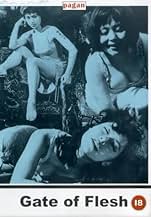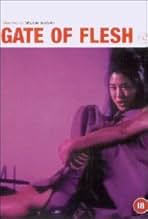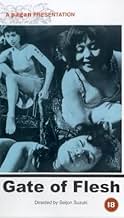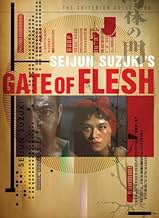VALUTAZIONE IMDb
7,2/10
3595
LA TUA VALUTAZIONE
Aggiungi una trama nella tua linguaAn injured thief on the run finds sanctuary within a brothel of united, ruthless women.An injured thief on the run finds sanctuary within a brothel of united, ruthless women.An injured thief on the run finds sanctuary within a brothel of united, ruthless women.
Jô Shishido
- Shintaro Ibuki
- (as Joe Shishido)
Chico Lourant
- Black Pastor
- (as Chico Roland)
Recensioni in evidenza
After WW II, a gang of prostitutes has their home base in the slums of Tokyo. They live in a world where the old generation of 'big shots still talk big.' For them, 'democracy means (having sexual intercourse with) foreigners.' These foreigners are GIs, members of the occupying forces in Japan. The main principle of the gang is 'no sex for free'. If a member of the gang transgresses this rule, she will be harshly punished. The movie contains some very sadistic lashing scenes.
Vision on mankind Seijun Suzuki unveils in an interview published on this DVD his view on mankind: 'physiology is the strongest force and only acts through human will. We can depend on nothing but the physicality of the flesh.' The gate to the world is the gate of flesh, where you have to 'rely on your own instincts'. Morality and religion, here represented by a black catholic priest, are hopeless pipe dreams.
Highly recommended, like other films by Seijun Suzuki's: his 'manga' movie 'Pistol Opera', his 'ghost' movie 'Princess Raccoon' (with Ziyi Zhang) and his gangster movie 'Underworld Beauty'.
Vision on mankind Seijun Suzuki unveils in an interview published on this DVD his view on mankind: 'physiology is the strongest force and only acts through human will. We can depend on nothing but the physicality of the flesh.' The gate to the world is the gate of flesh, where you have to 'rely on your own instincts'. Morality and religion, here represented by a black catholic priest, are hopeless pipe dreams.
Highly recommended, like other films by Seijun Suzuki's: his 'manga' movie 'Pistol Opera', his 'ghost' movie 'Princess Raccoon' (with Ziyi Zhang) and his gangster movie 'Underworld Beauty'.
This film proves that good directors are able to make first-rate films in spite of very modest budgets if they have the desire and creativity necessary to succeed. Essentially, this movie concerns the plight of a small number of prostitutes who are trying to survive in post-World War II Tokyo during the American occupation. With food, medicine, shelter and employment in scarce supply those without any resources became like animals just trying to stay alive. So 5 or 6 young prostitutes take refuge in a bombed out basement and agree to live by a very strict code which forbids, among other things, sex without payment. Those who fail to comply are tortured and then thrown back onto the cold streets without any means of protection or support. At any rate, things are going well for this small group until a war-weary Japanese soldier arrives suffering from a gunshot wound. Now, rather than giving away the entire plot I will just say that the director, Seijun Suzuki, uses various techniques (like different colors to differentiate the women) to create something quite impressive out of almost nothing. Just be advised that there is some nudity and violence that wasn't usual for this period in time. But even here he uses symbolism in many cases so that it doesn't seem crass or vulgar. In short, this is a picture that I recommend to those who can appreciate artistry and ingenuity and don't depend on special effects and CGI for their film entertainment. But it's not for the squeamish.
Having discovered the Female Prisoner Scorpion series recently, I've been looking out for more Japanese exploitation films and Gates of Flesh is an early example. The film is a bit artier than the other examples I've seen, and despite focuses on a nest of prostitutes; there isn't a lot of sex/nudity in it either. However, director Seijun Suzuki gets round this by giving the film a tremendously dark and unpleasant atmosphere that bodes well with the plot line as well as the time in which the film is set. The film is set shortly after World War II and we focus on a group of prostitutes who have come together to work for themselves. As a result, they have no pimp to answer to and so have to protect themselves also. They get a strict set of rules in place, which are enforced again by the girls themselves and the main rule states that none of them may give out what they sell for free. The group gets a new member in the form of a girl named Maya and shortly afterwards a thief seeks sanctuary with the prostitutes, and causes disruption within the group.
The plot is very ambiguous and it's never made clear exactly what the 'point' of any of the characters is, which on the one hand makes the film interesting as it means we have to work things out for ourselves; but on the other, the characters lack humanity and so the film can be a bit dry as a result. The director is apparently quite respected for making films like this; Gate of Flesh is the first one of his that I've seen so I cant comment on the body of his work, but clearly he is a director that values of the importance of making his films interesting and Gate of Flesh also looks very nice and the director gets the best out of his performers. I think that the director was hoping more to get a point across than anything else, but he also values style and that comes across well in the film also. The plot does flow fairly well, although at times it seems like there's not a lot happening so the film is not constantly entertaining. Overall, I won't name this film as a favourite of mine and I do prefer the more wild Japanese exploitation flicks; but this certainly isn't a bad film and I can recommend it.
The plot is very ambiguous and it's never made clear exactly what the 'point' of any of the characters is, which on the one hand makes the film interesting as it means we have to work things out for ourselves; but on the other, the characters lack humanity and so the film can be a bit dry as a result. The director is apparently quite respected for making films like this; Gate of Flesh is the first one of his that I've seen so I cant comment on the body of his work, but clearly he is a director that values of the importance of making his films interesting and Gate of Flesh also looks very nice and the director gets the best out of his performers. I think that the director was hoping more to get a point across than anything else, but he also values style and that comes across well in the film also. The plot does flow fairly well, although at times it seems like there's not a lot happening so the film is not constantly entertaining. Overall, I won't name this film as a favourite of mine and I do prefer the more wild Japanese exploitation flicks; but this certainly isn't a bad film and I can recommend it.
The story revolves around a female prostitution clan (Komasa of Kanto) and their newest arrivals, Maya and Shintaro (Jo "Cheek Implants" Shishido). It takes places in a shantytown located outside of a US military base, immediately after the end of WW2. They survive by selling their bodies and protecting each other, in other words : pimp-less. This is based on a novel by Taijiro Tamura.
We see the story from mostly Maya's perspective. When the story starts out she is a street urchin stealing food to survive. When she is caught by a local pimp and almost peddled to a couple of US servicemen, she inadvertently falls into the hands of the leader of the Komasa (the tattooed, Sen). From there the story revolves about the daily occurrences of street walking, finding food, laying about, singing and various methods of getting money, food and "johns" (lots of petty pickpocketing mostly).
The Komasa of Kanto are identified mostly by the color of their dresses than their names. It is funny to know that the color of the dresses in correspondence with the characters did not have any significant meaning (according to Seijun). The dressed adopted those colors because initially all the dresses and styles looked nearly identical. The colors were used (in typical anime fashion) to differentiate the characters. Mino - purple ; Roku - yellow ; Sen - red ; Maya - green ; Ofuku - white and Machiko - traditional kimono. The group have a few rules, but the most important is not to give up sex for free. We are subjected to the first incident of this with Ofuku. She is tied up, her hair is cut off and she is tied naked to a row boat and left in the harbor for all to see.
After Maya's arrival and adaptation, in comes Jo Shishido. He plays and ex Japanese soldier who goes around committing petty crimes and basically just trying to survive. His introduction is as the sole survivor of a failed raid on the military base supplies. He lives by a simple theory : eat, drink and have as much sex as you can. All the rest are pointless without these basic needs, so forget the higher ideals. He becomes part of Komasa when he stumbles into their "home" after he gets shot because he stabbed a US serviceman (who was involved in the theft at the base and "had it coming"). There is a brief power struggle between him and Sen, but his strength and power make for a natural leader. From then on, everyone defers to him. There also is an attraction for Shishido by both Sen and Maya and the entire groups tries to appease him.
There are elements of the baser and basic survival instincts of man. Those few things that try to elevate above it are crushed and extinguished. Seijun has some personal prejudices when it comes to this movie. He actually served in the Japanese army, stationed in the Phillipines. His military career started and ending with the Japanese retreating. At the time he still felt a bit angry at the US. This is represented in many fashions throughout the movie : the US GI rape of Maya, the MP's not caring, soup/ramen with a condom in it (merchant calls it healthy and nutritious food) and the appearance of the American flag. The flag is used every time something bad happens. It only has negative connotations, especially at the end where it is the last thing we see as the camera pans over the town. There also seems to be some mild capitalist vs communist debate going. At one instant one can hear the song of the international communist brotherhood being sung over all the dealings.
The movie is quite visually stunning. Takeo Kimura (the production designer) designed the sets. He was quite limited with funds. The movie need good sets but they were working with a B-movie budget. He used his theater background to create non-realistic surreal sets (theatre-like). They bring the movie (along with the costumes) to life. It gives the entire movie a theatrical feel. The bridge was even built with stolen used plywood from the props department. To make the paint go a long way, they would dilute the paint with water and add saw dust for thickening. This isn't a documentary. It is not suppose to emulate real life. It is an extreme look at life. Extreme characters in extreme circumstances. The movie also contains numerous scenes of nudity, female on female beatings, numerous sex scenes, plenty of violence and the butchering of a cow (which looks way too life-like). What more can one expect from the grandfather of the exploitation genre ?? I've seen numerous of Seijun's movies prior to this (the most recent being the Beast of Youth), but I was not expecting such a great movie. The Japanese cast and main actors do an excellent job. By the end you really care what happens to them. Seijun also included many American's in the cast as well, so expect to hear some English in the movie. I can't say enough about this movie. What are you still doing reading this, go out and see it for yourself.
-Celluloid Rehab
We see the story from mostly Maya's perspective. When the story starts out she is a street urchin stealing food to survive. When she is caught by a local pimp and almost peddled to a couple of US servicemen, she inadvertently falls into the hands of the leader of the Komasa (the tattooed, Sen). From there the story revolves about the daily occurrences of street walking, finding food, laying about, singing and various methods of getting money, food and "johns" (lots of petty pickpocketing mostly).
The Komasa of Kanto are identified mostly by the color of their dresses than their names. It is funny to know that the color of the dresses in correspondence with the characters did not have any significant meaning (according to Seijun). The dressed adopted those colors because initially all the dresses and styles looked nearly identical. The colors were used (in typical anime fashion) to differentiate the characters. Mino - purple ; Roku - yellow ; Sen - red ; Maya - green ; Ofuku - white and Machiko - traditional kimono. The group have a few rules, but the most important is not to give up sex for free. We are subjected to the first incident of this with Ofuku. She is tied up, her hair is cut off and she is tied naked to a row boat and left in the harbor for all to see.
After Maya's arrival and adaptation, in comes Jo Shishido. He plays and ex Japanese soldier who goes around committing petty crimes and basically just trying to survive. His introduction is as the sole survivor of a failed raid on the military base supplies. He lives by a simple theory : eat, drink and have as much sex as you can. All the rest are pointless without these basic needs, so forget the higher ideals. He becomes part of Komasa when he stumbles into their "home" after he gets shot because he stabbed a US serviceman (who was involved in the theft at the base and "had it coming"). There is a brief power struggle between him and Sen, but his strength and power make for a natural leader. From then on, everyone defers to him. There also is an attraction for Shishido by both Sen and Maya and the entire groups tries to appease him.
There are elements of the baser and basic survival instincts of man. Those few things that try to elevate above it are crushed and extinguished. Seijun has some personal prejudices when it comes to this movie. He actually served in the Japanese army, stationed in the Phillipines. His military career started and ending with the Japanese retreating. At the time he still felt a bit angry at the US. This is represented in many fashions throughout the movie : the US GI rape of Maya, the MP's not caring, soup/ramen with a condom in it (merchant calls it healthy and nutritious food) and the appearance of the American flag. The flag is used every time something bad happens. It only has negative connotations, especially at the end where it is the last thing we see as the camera pans over the town. There also seems to be some mild capitalist vs communist debate going. At one instant one can hear the song of the international communist brotherhood being sung over all the dealings.
The movie is quite visually stunning. Takeo Kimura (the production designer) designed the sets. He was quite limited with funds. The movie need good sets but they were working with a B-movie budget. He used his theater background to create non-realistic surreal sets (theatre-like). They bring the movie (along with the costumes) to life. It gives the entire movie a theatrical feel. The bridge was even built with stolen used plywood from the props department. To make the paint go a long way, they would dilute the paint with water and add saw dust for thickening. This isn't a documentary. It is not suppose to emulate real life. It is an extreme look at life. Extreme characters in extreme circumstances. The movie also contains numerous scenes of nudity, female on female beatings, numerous sex scenes, plenty of violence and the butchering of a cow (which looks way too life-like). What more can one expect from the grandfather of the exploitation genre ?? I've seen numerous of Seijun's movies prior to this (the most recent being the Beast of Youth), but I was not expecting such a great movie. The Japanese cast and main actors do an excellent job. By the end you really care what happens to them. Seijun also included many American's in the cast as well, so expect to hear some English in the movie. I can't say enough about this movie. What are you still doing reading this, go out and see it for yourself.
-Celluloid Rehab
An exploitation film with a brain. We see nude women tastefully lit, kinky violence - women beating other women and the low life of Tokyo outdoing each other in even more dastardly acts of treachery and heartless thuggery. The intelligence comes with the strong impact of the women dressing in vibrant red, purple, yellow and green to reflect their characters. Having the prostitutes live in a building that is an analogy for post-war Japan is even smarter. The building is bombed out, its occupants desperate, many have lost family in the war and for some the sight of people burned to death has made them individually heartless, desperate and mad. The fact that most of them live in the basement indicates that they have plummeted into the depths of hell. For cinema goers in Japan in 1964, just enjoying the fruits of the boom years for their rebuilt economy and also a new found pride and respectability, this must have been a sobering but also satisfying reminder of where they had been and how far they had come.
Lo sapevi?
- QuizIn an interview Seijun answered the question of the uniqueness of this film in relation to other B/Program pictures he made in the time: "The studio wanted to make a skin flick, that's all. We couldn't make a real porno back then, though."
- BlooperA downward shot pans across a crowd following a stretcher. When straight down, you see the shadow of the camera, crane and the camera operator.
- ConnessioniFeatured in From the Ruins: Making 'Gate of Flesh' (2005)
I più visti
Accedi per valutare e creare un elenco di titoli salvati per ottenere consigli personalizzati
- How long is Gate of Flesh?Powered by Alexa
Dettagli
- Data di uscita
- Paese di origine
- Lingue
- Celebre anche come
- Barriera di carne - La porta del corpo
- Luoghi delle riprese
- Azienda produttrice
- Vedi altri crediti dell’azienda su IMDbPro
- Tempo di esecuzione
- 1h 30min(90 min)
- Mix di suoni
- Proporzioni
- 2.35 : 1
Contribuisci a questa pagina
Suggerisci una modifica o aggiungi i contenuti mancanti
























